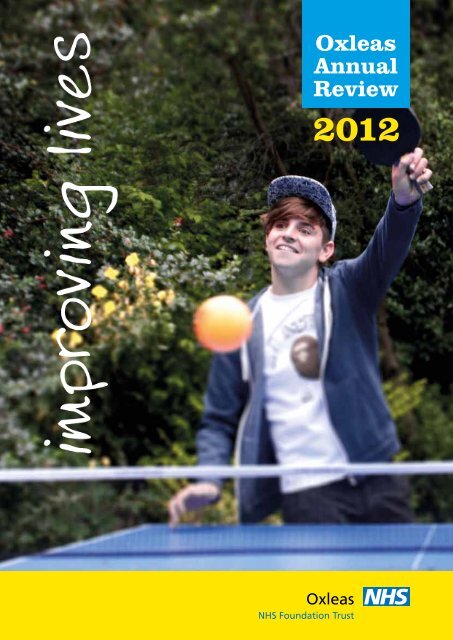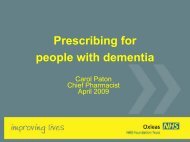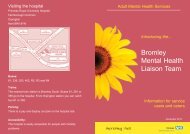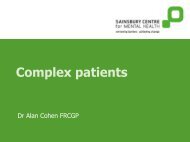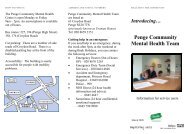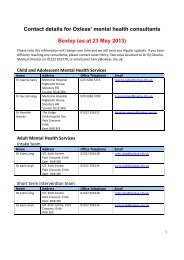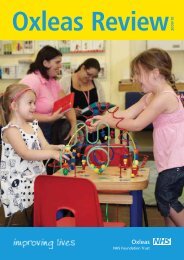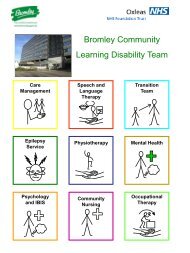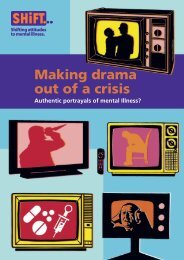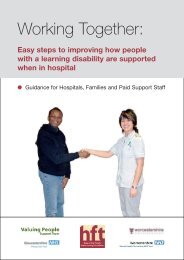Oxleas Annual Review - Oxleas NHS Foundation Trust
Oxleas Annual Review - Oxleas NHS Foundation Trust
Oxleas Annual Review - Oxleas NHS Foundation Trust
You also want an ePaper? Increase the reach of your titles
YUMPU automatically turns print PDFs into web optimized ePapers that Google loves.
ANNUAL REVIEW 2012Stuart BertramA therapeuticenvironment fordementia careAre people with dementia disabled by their condition or by theirenvironment? This intriguing question was raised by Stuart Bertram,an occupational therapist (OT) at the Woodlands Unit, Queen Mary’sHospital, Sidcup.Stuart started work in Woodlands in January of this year. Since then he has beena key figure in designing and creating a therapeutic environment on Camden Wardthat engages patients with dementia and promotes their independence.He previously worked as an OT for social services in Hertfordshire.For someone keen to increase his experience of working with older people ina variety of health settings, Stuart joined us at an exciting time. A completelynew directorate for older people had recently been established and a projectlooking at how older people’s services were delivered had resulted in thedecision to establish a centre of excellence for the care of people with dementiaat the Woodlands unit. This was to comprise two dedicated dementia wards:Camden Ward for men and Leyton Ward for women. Stuart takes up the story:“The idea was to refurbish the wards and provide a new conservatory thatwould be accessible from both wards and allow access into the garden. Estatesand Facilities were already working with architects experienced in buildings forpeople with dementia, but we wanted to be able to have the work accredited.I was aware of the excellent work in this area done by the University of Stirling’sDementia Services Development Centre so we purchased their Dementia DesignAudit Tool.”Based on research carried out by the University of Stirling, the tool gives detailedguidance on how to create an environment that will best support people withdementia. Stuart used it to carry out an audit of Camden Ward, and sent theresulting report to Estates and Facilities Project Manager Colin Cope. Colin workedwith Stirling University’s audit tool to ensure we were able to meet basic designprinciples of what is considered a dementia friendly environment. Work beganin late January 2012 and was completed in June. Stuart again: “People withdementia need more light to help with clarity of vision and have a diminishingability to differentiate between colours and difficulty seeing in three dimensions.For example, if floors, skirting boards and walls do not contrast, a person withdementia may not be able to perceive where the floor ends and the wall begins.This can be incredibly disorientating, cause unduestress and anxiety, worsen symptoms of dementiaand increase risk of falls. So, when designing the newcolour scheme for Camden Ward, we concentratedon providing contrast so that each object could beclearly perceived. Bathrooms with white walls, sinksand toilets are a particular problem so we usedstrongly contrasting colours for toilet seats andhandrails. As well as minimising risk, this encouragespeople to use the bathroom by themselves, thuspromoting independence.”Careful thought was also given to how patientsnavigate themselves around the ward, and findtheir way back to their rooms. The three corridorsare colour coded purple, yellow and blue, and thefurnishings in the bedrooms match these colours.There is also a correspondingly painted wooden panelon each bedroom door and a sign with their nameand a photograph or picture chosen by the occupantof that room.Signs are wherever possible placed on the door towhich they relate and sited about four feet from theground where they can be easily seen by older peoplewho may have lost muscle strength in their shoulderscausing their heads to hang down.Flooring with a matt finish was also installed as peoplewith dementia often perceive shiny finishes as beingwet and may be too nervous to walk on them. Thisalso encourages them to move about independently.Dead ends, for example where there is a locked doorat the end of a corridor, can be a particular problemcausing frustration and anger, butStuart explains there is a solution:“We create interest in these areas, forexample by placing old photographs of thelocal area that spark reminiscence, or ‘memoryboxes’ which could contain things like coins, old bustickets etc. These things help to distract patients,prevent distressing thoughts and provide a meansof spontaneous reminiscence.”For Stuart, creating the ideal environment is all about‘normality’. So there is a sitting room area completewith comfy chairs, coffee table, fireplace, TV andbookcase. The chairs have arms and ‘wing backs’that support patients to sit comfortably and safelyand some have detachable arms for wheelchair users.Patients can also move freely between the two wards,socialise and form friendships. Stuart points out thatby creating a stimulating and calming environmentpeople are happier and the need for drugs may bereduced: “We want to create a culture of activitywhere we can assist people to carry out everydayactivities such as cleaning their teeth or brushingtheir hair. We have introduced menus giving people achoice of meals and we encourage them to help laythe tables and clear up afterwards. Changes to theenvironment, such as those we have introduced onCamden, can enable people to do normal things thatwill help them to be as well as they can. This will helppatients when returning home or moving intoa residential unit.”A limited refurbishment of Leyton Ward focusing onsanitary facilities and storage areas is due to startlate this year. Work will be in line with what is goodpractice for people with dementia.2 OXLEAS <strong>NHS</strong> FOUNDATION TRUST3
ANNUAL REVIEW 2012Falls represent a serious problem for older people;they occur in around 30% of over 65s and50% of those aged over 80 every year, oftenresulting in serious consequences, both physically andpsychologically. In addition to bruising, fractures, andin some cases, death, a fall can destroy confidence,increase isolation and reduce independence.Falls affect people whether they use our physical,mental or learning disability services and ourCommunity Falls Team has been working hard topromote falls awareness and prevention by forginglinks with colleagues across these services.The falls team, which joined us with GreenwichCommunity Health Services in 2011, is part of theCommunity Assessment and Rehabilitation Team,which looks after people with long term physicalhealth conditions and has a particular focus onavoiding hospital admissions.Falls team lead Wendy McDermott points to solidachievements over the last year: “We’ve set up a trustwide falls and bone health steering group whose firstobjective is to develop a falls policy that encompassesall our services. Falls team staff have also provided aconsultation service where we give help and advice onfalls awareness and prevention to colleagues includingthose in mental health and learning disability services.For example, we have shared our falls screening tooland care pathway with colleagues across the trust. Wehave provided falls training to staff in a number of carehomes and district nursing teams. We have workedin partnership with Active for Health Greenwich thatruns exercise groups in the community, providingthem with evidence based exercises. We also supportcolleagues to carry out falls audits in their areas andmake appropriate recommendations.”The team has attended local public events to promotefalls awareness and falls prevention including eventsduring Falls Awareness Week in June. During these,they were on hand to offer information and adviceat a Nepalese exercise class in Woolwich and a ThaiChi session at West Thamesmead’s Bevan Unit, whichcares for those finding it difficult at home or whoneed support and rehabilitation before returninghome from hospital.During the last calendar year (January to December2011) the falls team received 1,090 referrals, anaverage of 91 per month. The team conducts regularreviews to gather patient experience of the service,undertaking 210 in this period. These showed that86% of patients had not fallen following a six monthreview, demonstrating the impact of good fallsmanagement. No serious injuries or fractures werereported.Upon discharge, satisfaction questionnaires are sentto patients, and of 231 returned, 225 said they hadbenefited from the service. Things that patients foundparticularly valuable included: advice and information;encouragement; having someone to contact; exercisesand being able to do things for themselves.Adapted Tai Chi exercises at the Bevan Unit, Thamesmead.Txt msg service is GR84 young PPL in BexleyThe school nurses in Bexley have pioneered anew and confidential text messaging healthservice for young people aged 11-18 in theborough’s 17 secondary schools. Young people textthe School Nursing Team with their query and receivea reply by text.Since it was introduced last year, the text messagingservice has gone from strength to strength withincreasing numbers of young people texting in toask about a range of issues including sexual health,contraception, emotional health and smokingcessation advice.School Health Advisor Jane Sweeny was instrumentalin setting up the service which she says addressed anexisting need: “As school nurses, we were gettingfeedback from the children that they wanted somesort of confidential advice service outside of theone hour a week drop in service we operate in eachschool. We sent a questionnaire to 150 young peopleasking them how they would like to receive healthadvice. 57% responded saying they would prefer toreceive advice by text and 15% said they would usethis method although it wouldn’t be their first choice.We launched the text messaging service as a result ofthis positive feedback. I really believed in it and pushedfor the service to be set up.”Texts are received and responded to 9am-4pm,Monday to Friday, on two dedicated phones, one ateach location. Jane is clear about the benefits: “Youngpeople can now get help and advice throughout theyear rather than once a week during term time. Andbecause it is anonymous, it’s easier for them to askquestions that might be difficult face to face. In thisway we can reach more people than previously. Mostof the queries are about sexual health, though we alsoreceive questions about emotional and mental health.“If the team think more help may be needed, they givepeople details of their school nurse and drop in serviceor direct them to other sources of advice and support.Patient experience is monitored by automated textssent following the advice thanking the young peoplefor using the service and asking if they found it useful.Responses so far have been overwhelmingly positive.Young people in Bexley can text for advice on07880 783 560, or 07880 784 446Thai Chi group at the Bevan UnitFalls preventionimproves quality of lifeThis included formulating operating guidelines,steering it through governance and quality assuranceand winning the support of Transformation ManagerMaria Tanner. Jane and the team then promotedthe new service and number to text in schools withposters and at-a-glance information in credit card sizeformat. In the first year the team dealt with 456 textsand this year had received 280 up to July.The team is based in the Erith Health Centre andat Wrotham Road, Welling and the text messagingservice is run by five qualified school nurses.Jane Sweeny4OXLEAS <strong>NHS</strong> FOUNDATION TRUST5
ANNUAL REVIEW 2012Staff fortunate enough to hear BaronessNeuberger talk at our Getting Older – LivingWell conference in March probably expecteda polished talk. What they may not have bargainedfor was an inspirational account of the meaning andpurpose of our lives - all delivered in 15 minutes.Baroness Neuberger has had a distinguished career inpublic life. She is a noted social commentator and iscurrently Chief Rabbi of West London Synagogue anda crossbench peer in the House of Lords.Staff from our mental health, learning disabilityand community health services got together at theconference to consider how integrating these servicescould provide better care for older people. Duringthe morning, speakers explored themes includingThemeaningof life Baronessthe relationship between physical and mental health,social isolation, how staff can work together andcaring for people at the end of life. In the afternoon,round table discussions debated whether integratedcare for older people can make a difference anduniversally decided that improving and maintainingcommunications between different services wasessential.But the highlight of the day was Baroness Neuberger’sthoughts on the meaning and purpose of life for olderpeople. Not mincing her words, she said the wayour society often treats older people is disgraceful:“Feeling loved and cherished and wanted is a hugepart of what makes life worth living. Even when thingsare not going well, if we feel secure of our place insociety we are ok. The problem for older people is thatthey are often abandoned by society.”The baroness summed up what she thought healthprofessionals need to take account of: “We all needa sense of purpose and to feel needed. We need thisall of our lives, including when our physical or mentalcapacity isn’t great. Friendship is also important tous throughout our lives. People with dementia stillreact when you touch, sing, or talk to them. Our needfor human contact lasts to the end of life, even withdementia. Finally, we need to recognise the sufferingand loss that older people experience. People areoften afraid to talk to them about what they imaginemay be painful memories, but this is wrong. Olderpeople want to remember and talk about the past.It’s the memory of people they have loved and lostthat consoles and sustains them every day.”Baby feedingprogrammewins UNICEFapprovalA10 year collaboration in Greenwich hasresulted in us becoming one of the first trustsin the country to achieve joint UNICEF Stage3 Baby Friendly accreditation.Health visiting teams from Greenwich CommunityHealth Services, which joined us in 2011, worked inpartnership with colleagues from Queen ElizabethHospital, Woolwich, the University of Greenwichand Greenwich Council children’s centres to ensurethat mums in the borough had access to the higheststandards of breastfeeding and infant feeding advice.This partnership is called the Greenwich BreastfeedingStrategy and its aim is to increase breastfeeding ratesin Greenwich and ensure that mums get the bestquality information and support.Breastfeeding rates in the UK are still among thelowest in Europe and mums have been working withhealthcare professionals to change this.In pursuit of this goal, the Greenwich BreastfeedingStrategy worked with UNICEF UK, a charity thatfocuses on children and child rights worldwide. TheirBaby Friendly Initiative works with healthcare systemsto ensure a high standard of care in relation to infantfeeding for pregnant women and mothers and babies.It accredits maternity and community facilities thatadopt internationally recognised standards of bestpractice in three stages. Stage 3 assesses the careprovided to pregnant women and new mothers.Neuberger A breastfeeding group in GreenwichLiz Ginty is one of two infant feeding advisors, theother being Janet Blake. Liz said: “There has been lotsof user involvement from the start and this has reallygiven the project impetus. For example, the GreenwichMUM2MUM project is a network of local volunteermums who receive training to help them promotebreastfeeding in their local communities.”Janet, also a health visitor, said: “This success reflectsall the hard work by health visiting teams in supportingGreenwich mothers and families. UNICEF particularlypraised our breastfeeding support groups that runevery day in children’s centres across Greenwich.”UNICEF staff visited children’s centres acrossGreenwich and talked to mums about the advicethey had received from our staff. Questions includedwhether mums received advice on how to express milk(a way of taking milk from the breast without the babysuckling) and a staggering 98% told UNICEF they had.6OXLEAS <strong>NHS</strong> FOUNDATION TRUST7
ANNUAL REVIEW 2012AnightofmanyartistsKim NobleImagine having 20 ‘main’ personalities sharing yourbody. They are all different and many of them areartists. Well, a Bromley audience of 120 peopleenjoyed a fascinating evening last November with sucha person – Kim Noble.Kim Noble has dissociative identity disorder (formerlyknown as multiple personality disorder). This is acomplex disorder that many people find hard tobelieve (including, at one point, Kim). This has causedmany problems over a 35 year period resulting inchaotic involvement with mental health services.However, Kim is a mother and a very successful artist.The Central Library crowd found out how art haschanged Kim’s life. Her work is widely sought afterand she has made numerous TV appearances includingThe Oprah Winfrey Show.The event was produced and run by ResearchNet, aservice user and carer research group interested in allaspects of mental health. It was designed as part ofa research project to look at public attitudes towardmental health issues. The evening introduced Kim’sfascinating story and showcased her art. People hadthe opportunity to purchase a signed copy of Kim’sautobiography – All Of Me.Many ResearchNet members are on our innovativeVolunteer to work scheme and two were extremelyaccomplished on the night in their Master ofCeremony duties.Another highlight of the evening was the questionand answer session. Kim was asked ‘Do all yourpersonalities paint?’ Kim replied: “No. Fourteen ofthem do but I have 20 personalities one of whom hasrequested that her artwork is not shown.” Anothermember of the audience asked if Kim had a differentwardrobe for each of her personalities. She said it’scalmed down a bit now – but that she used to changeoutfits several times a day.Out and aboutIt would be hard to find a more positive role modelfor lesbian, gay, bisexual and transgender (LGBT)staff and patients than Maeve Malley. A winningcombination of energy, enthusiasm, commitmentand laughter, Maeve is a Consultant SystemicPsychotherapist who has worked for <strong>Oxleas</strong> formore than six years.Maeve has always been ‘out’ at work and believes thatthis is important to her clinical practice: “To be thebest you can be at work you have to use the wholeof yourself, and that includes your sexual identity.This is important when building trust and relationshipswith other people. In my own area – systemicpsychotherapy – we work with families, couples,even organisations, and focus on the many differentsystems – or relationships - that surround people,rather than just on their internal worlds. I think it isimportant that clinicians help patients who are LGBTto feel safe discussing the whole of their lives as thishas a beneficial effect on outcomes.”Maeve thinks the issue of visibility is key:“It’s very important that people get their headsaround visibility. I’ve genuinely noticed a change forthe better since I joined the trust and I think thisis down to the role of the trust’s LGBT Network.It provides a focus and an LGBT identity within<strong>Oxleas</strong> and also performs a proactive role, forexample producing leaflets and posters.”According to Maeve, the presence of LGBT postersand leaflets in waiting rooms is a visible recognitionby the trust of sexuality: “Heterosexuality is alwaysthe default and people who are LGBT can becomeinvisible. So the acknowledgement of difference is veryimportant. My experience is that when this happens,both staff and patients are able to be ‘ordinary’ talkingabout, and being asked about, their lives. It also makesa difference to who chooses to work for us and whouses our services.”This is important when one considers that earliermodels of psychotherapy traditionally regardedpeople who were LGBT as being emotionally ormentally disordered. Maeve says: “It was not benignto LGBT identification issues. So increasing visibilityhelps people to feel more comfortable using ourservices, whether they choose to talk about theirlifestyle or not. And as this group is more vulnerableto anxiety because of their sexuality, it is likely thata disproportionate number of our patients willbe LGBT.”Maeve Malley12OXLEAS <strong>NHS</strong> FOUNDATION TRUST13
ANNUAL REVIEW 2012“The trust website already has lots of informationCaringaboutourcarersSupporting families and carers is one of ourpriorities and the philosophy behind our Carers’Strategy. The first Carers’ Strategy (2008-2011)focused on involving the carers of people with mentalillness or learning disabilities as partners in care whilethe new strategy (2012-2015) includes the carers ofpeople with physical illnesses.The driving force behind recent improvements forcarers is <strong>Trust</strong> Carers’ Lead Anna Chan. One of themost important initiatives has been Family InclusivePractice Training, facilitated by the PsychologicalTherapies Team, which involves carers in helping staffSusan St James has cared for her son who has hadmental illness since 1999 and is a firm believer in theimportance of support groups: “When my son wasfirst diagnosed I found it traumatic. I didn’t knowwhat questions to ask the doctors or nursing staff.That’s why carers’ support groups are so important.I think that details of local groups should be includedin carers’ packs and these should be the first thingnew carers receive when they walk through the door.”Before carers can be supported we need to find outwho they are, and this is why, according to Anna,recording their details is so important: “Once we havetheir details, we can offer them a carer’s assessment,consult them on changes, let them know abouttraining for carers and invite them to carers’ events.”One of the ways we do this is by recording the carersof patients on Care Programme Approach (CPA) onour clinical system. Under Anna’s leadership recordingis running at 92.9%.Anna again: “The trust recognises that carers’assessments are essential for identifying carers’ needsso staff have been trained to carry them out. Myown background in IT enabled me to design monthlyreports that measure the number of carers beingoffered carers’ assessments by different teams.This has enabled teams to plan workloads betterSusan St James supports carers’ assessments and isfrank in her appraisal of how they should work. Shesaid: “They should be about me, what I can and can’tdo. The last two were all about my son, but they needto know how I care for him and what my abilities are.For example, I have arthritis and have just had a hipreplacement. I made sure that staff knew about thisbut often they don’t think about the support thatcarers need – and don’t ask.”The new 2012-2015 strategy seeks to consolidateand build on progress already made and,crucially, will apply to everyone who receivesservices from us or who works for us. This isnot without its challenges, as Anna explained:“The need to find cash releasing efficienciesmeans that in future we are planning to offercare awareness training as an e-learning course.A big challenge concerns community healthservices (CHS), where at present we have verylittle information recorded about carers. We areplanning to train CHS staff to address this.about mental health conditions that carers can accessand this will be expanded to include physical healthconditions. Carers will be able to access this directlyor staff can print out information for them.“Another important part of the new strategy has beento set up the trust wide Family and Carers StrategyGroup. Its role is to monitor and help progressimplementation of the strategy and also to reviewtrust publications to ensure they take account ofcarers’ needs.”to understand what it’s like to be a carer. Accordingto Anna: “In the two years to March 2012, we trained75 mental health and learning disability teams. Teamsheard carers talking about their experiences and thiswas the most powerful part of the course.”Another key element has been the establishment ofcarers’ support groups in mental health services. Annaagain: “Both the number of groups and attendance atand driven up the number of assessments beingcarried out.“Carers’ assessments are so important because theyenable us to build a picture of each carer’s situationand how they cope. They gather information aboutthings like shopping; banking; or how their caringrole affects their physical or mental health, work orrelationships. This enables staff to offer suggestions“Confidentiality is a big issue for many carersand other plans include a common senseconfidentiality guide to inform carerswhat sort of information they canexpect to get from staff and whysome information can’t be sharedwith them. The guide will beavailable later this year.them has grown steadily. All mental health acute unitson how to cope, for example giving information aboutnow have carers’ support groups and most recoverycounselling or carers’ support groups, or discussingteams have them too.”medication and medical conditions.”Anna Chan14 OXLEAS <strong>NHS</strong> FOUNDATION TRUST15
ANNUAL REVIEW 2012Making a differenceFor Stephen Firn, becoming Chief Executive of <strong>Oxleas</strong> in 2002 was theculmination of a lifelong desire to make a positive difference to people’s lives.Originally from Yorkshire, Stephen lives in South London with his wifeand three sons aged from nine to 20. He is a keen runner and has successfullycompleted four marathons.In the early 1980s, Stephen went travelling in Europe where he met a group ofnurses who inspired him, on his return, to apply for a position in a local psychiatrichospital. Stephen takes up the story: “I asked if they had any jobs and started thenext day. There was no induction and no Criminal Records Bureau (CRB) checks.While there I met an inspirational dementia ward manager who had made ahaven for the patients – in contrast to the rest of the institution. I thought, wow,you can really make a difference to people’s lives, so I applied for nurse training.I came to London in 1985 and spent the next 11 years at the Maudsley Hospital.I then worked as a research nurse, a lecturer, and at the Department of Health.All the time I was trying to make a difference. This has been the common threadthroughout my career but, to some extent, I always felt frustrated. But when I gotthe opportunity to come to <strong>Oxleas</strong> in 1996, as a manager in an organisation thatprovided care directly, I felt most able to have an impact on the quality of patientservices.”Looking back over an eventful year, Stephen has enjoyed welcoming newservices and staff to the trust: “Getting to work alongside and support people incommunity health services, including clinical staff such as paediatricians and a newrange of allied health professionals like dentists and music therapists has been veryrewarding.“We are already seeing really good collaborations that are helping us to treat mindand body. For example, our specialist integrated children’s service that began inSeptember. And we will see even more of this when our new Children and YoungPeople’s directorate is launched in October.“One of the most impressive things I have seen has been the collaboration betweenstaff from older people’s mental health services and their physiotherapist colleaguesover falls prevention.“Results from the Staff Survey this year have also been very positive. This isimportant as what colleagues say and feel about working for <strong>Oxleas</strong> has a directrelationship to the quality of care they provide. We were the second best trustoverall in the country which is incredibly encouraging. And we came top for sevenquestions, including staff’s satisfaction with the quality of care they are able toprovide, which is so important.”A recent challenge has concerned the administration process at South LondonHealthcare <strong>NHS</strong> <strong>Trust</strong> (SLHT). According to Stephen: “This has created uncertaintyfor our colleagues in SLHT and for local people. Our responsibility is to workwith the administrator, commissioners and other providers to help to resolve theuncertainty as soon as possible and to help deliver safeand sustainable services.”Foremost among the difficult experiences that Stephenhas had over the last year has been meeting withthe family of Sally Hodkin, who died as a result of anincident involving one of our patients. Stephen said:“Meeting bereaved families is always difficult, but itis an essential part of my job because they need toknow firstly that we take the incident seriously andinvestigate it and secondly that we learn any lessonsand act upon them.”Looking ahead at <strong>Oxleas</strong>’ role in a changing <strong>NHS</strong>,Stephen remarked: “In future more care will have tobe delivered in the community and in people’s ownhomes. We can no longer afford to have so manylarge expensive hospitals and these are not alwaysthe best way to deliver patient choice. Most peopleat all stages of life would rather receive care at theirlocal health centre or at home, and this is true fromgiving birth right through to end of life care. In thisenvironment, <strong>Oxleas</strong> will continue to have a vital roleas a major community provider of both mental andphysical healthcare services.“There will be more voluntary sector (not forprofit) providers and more opportunities to work inpartnership. For example, the trust already worksclosely with local mental health charity Bridge, whoseChief Executive Officer is our lead governor. It’sabout more patient choice and that’s not a bad thing.“Local commissioning of services is going to beclinically led by GPs so working closely with primarycare partners will be absolutely critical. One of thethings we have done is to ask all our local GPs to seewhat they think of our services and how we can workbetter with them.”While Stephen clearly believes there are opportunitiesto improve services, he is not complacent about therisks. “Too rapid expansion, for example, runs the riskof losing our focus on existing services. It has takenmany years to build the positive and distinctive culturein <strong>Oxleas</strong>. I think it’s true that ‘culture eats strategy forbreakfast’ and you can have the greatest strategy inthe world, but unless you’ve got the right culture youcan’t deliver anything. We’ve got a good culture andwe mustn’t lose that.”In leading the trust, Stephen believes in a hands-onapproach: “I meet all new staff at induction and writeto them a few weeks later to see what they think. Ispend at least one day a month visiting a particularservice, typically meeting about 10 teams. I always sayI’m not there to give them a lecture but to listen andlearn about what they’re doing and what I can do tohelp them to do things better.“I couldn’t do this job unless I enjoyed it. It’s aprivilege. Every job has its difficult moments butI enjoy it hugely and 10 years have flown by.”Stephen Firn, Chief Executive18 OXLEAS <strong>NHS</strong> FOUNDATION TRUST19
ANNUAL REVIEW 2012How understandingautism broughtpeace to a familyIntegratedserviceswill deliverbetter carefor childrenResponsible for planning and assembling the newADHD team is CAMHS’ Consultant Child andAdolescent Psychiatrist, Stephen Warren. Stephenexplained why Greenwich commissioners hadinvited bids for the new service structure: “Healthcommissioners looked at a number of things includinghow to reduce visits to A&E and hospital admissions.They wanted the service to encompass the full rangeof children’s health needs and the needs of theirfamilies.”Integrated services for children have been the HolyGrail for both providers and commissioners foryears. Child and adolescent mental health services(CAMHS), community health services and localauthorities have all sought greater integration in thebelief that it would deliver better care more efficiently.An important element of the services sought by thecommissioners was to provide support for somechildren with ADHD. According to Stephen, it isparticularly important for children with ADHD to beseen early as this has a positive effect on outcomes:“I hope the new service will lead to improved jointworking for all children with ADHD but those withNow, in 2012, developments within Greenwich aregoing some way to make this vision a reality. Themore complex problems will still be supported byCAMHS or community paediatrics.”Many families look forward to meal timesas opportunities to spend quality timetogether. But, for one Blackheath family,they could be more like a battleground before theywere referred to our services.For Marcus, then aged 13, had undiagnosed autism.We have chosen him for our front cover because hisfamily are happy for us to tell his story and want toshare their positive experience of our services.Mum Jo takes up the story: “We didn’t know whatwas wrong. So we thought he was being awkwardwhen he wouldn’t do as he was asked or refused toeat his food. I was also getting calls from his teachersevery day complaining about his lack of concentration.The breakthrough came when Marcus changedschools, aged 13, and his new teachers noticedunusual behaviour. His head teacher suggested thatwe should consult our GP about a possible referral.”Marcus was referred to our Community PaediatricService based at Wensley Close, Eltham, where he wasassessed by a total of four doctors.Marcus was on the autistic spectrum. The wholeprocess was quite fast and we are very happy withthe support we have received. <strong>Oxleas</strong>’ staff taught usabout things like how the texture or colour of foodcould upset him, how to talk to him and helped usunderstand what makes him stressed. They equippedus as a family to enable Marcus to carry on asnormal and helped us make his teachers aware of hiscondition. I have put a chart on his wall showing hisdaily activities and his teachers have adapted the waythey speak to him so he feels comfortable. We areless stressed as a family and meal times are muchcalmer. He’s 15 now, getting on fine and doing verywell at school.“Marcus has been discharged and thanks to thesupport we have received, we are managing hiscondition at home. But we know that we can alwayscontact <strong>Oxleas</strong> if we need help.”Our children’s services, including communitypaediatrics, will be joining our child and adolescentmental health services (CAMHS) in a new Childrenand Young People’s directorate from 1 Octobertrust has recently won a tender from <strong>NHS</strong> Greenwichto provide a new integrated children’s service inGreenwich. This will be an extension of some existingservices currently provided by <strong>Oxleas</strong> and SouthLondon Healthcare <strong>NHS</strong> <strong>Trust</strong> (SLHT) and also threenew specialist services for children with epilepsy,attention deficit hyperactivity disorder (ADHD) anda dietetics service. These services went live on 1September and on 1 October the new trust-wideChildren and Young People’s directorate will beformed.Among those who have joined us from SLHT is a teamof community children’s nurses. Based at WensleyClose, Eltham, the team will work closely with existingservices. Kate Medhurst, Team Lead, said: “All of usare paediatric nurses and have undertaken furthertraining to support children and young people in thecommunity.”Integrated children’s services include: communitypaediatric dietetics; ADHD service; epilepsy service;community children’s nursing; and children’scontinuing care and end of life care.Stephen continued: “This will be the first example ofan integrated children’s service that bridges CAMHSand specialist children’s services and I will be workingwith clinical managers and the heads of therapeuticservices within community and local health services todevelop it.”Jo again: “The final consultation lasted all day and(see page 23).involved all of us. This is when we found out thatStephen Warren20 OXLEAS <strong>NHS</strong> FOUNDATION TRUST21
ANNUAL REVIEW 2012New directorate structure explainedFrom 1 October 2012 we will be adopting a new structure to the way in which our services are managed.The new structure outlined below is designed to improve patient care and efficiency however the changesare management based and will not affect the services that people receive.In April 2011 we moved our adult and older adult mental health services into directorates based on specialitiesrather than boroughs. We are carrying out a similar process with community health services and the changes willsee all services for children and young people in one directorate, adult community health services in another andadult learning disability services joining the Adult Complex Needs and Recovery directorate.Adult AcuteMental HealthServices• Greenwich Time To Talk• Liaison and intake teams• Short term intervention teams• Adult inpatient wardsTrevor Eldridge, DirectorDr Anthony Akenzua,Clinical DirectorChildren andYoung People’sServices• Child and adolescent mentalhealth services (CAMHS)• Specialist communityhealth services• Universal communityhealth services• Therapies• Services for adopted andlooked after childrenAdult ComplexNeeds andRecovery Services• Adult Learning DisabilityServices (ALD)• Recovery teams• Early intervention services• Assertive outreach teams• Community rehabilitationservices• Inpatient rehabilitation units• Horizon HouseIain Dimond, DirectorDr Jonathan West, Clinical DirectorDr Lorraine Regan, Associate Director& Clinical Director, ALD ServicesForensic andPrison Services• Bracton Centre MediumSecure Hospital• Bracton Community Team• Specialist physical and mentalhealth services in Kent prisonsAdult CommunityHealth Services• Unscheduled care services• Long Term Conditions• Planned careJane Wells, DirectorDr Suzy Taylor, Clinical DirectorOlder PeopleMental HealthServices• Inpatient wards• Community teams• Day and memory servicesA wonderfulopportunity forchildren’s servicesThe man tasked with making <strong>Oxleas</strong> newChildren and Young People’s directorate a realityis no stranger to children’s services. StephenWhitmore began his working life as a social workerquickly specialising in working with children and, whenhe joined us in 2003, it was as Director, Child andAdolescent Mental Health Services (CAMHS) and AdultLearning Disability Services.In his new role as Service Director, Children and YoungPeople’s Services, Stephen will play a central role increating and establishing the new directorate. It will,for the first time, bring together CAMHS services andchildren’s services that were previously within Bexleyand Greenwich community health services.Stephen said that the new structure will help usto promote the integration of mental health andcommunity health services and improve care forchildren and families: “It will provide children andfamilies with one logical place to go for their supportand will make their involvement with services morestraightforward. It will also clarify who is responsiblefor care and make it easier for referrals to be madeand for partner organisations to access the service.A substantial minority of children and young peopleneed two or more separate (mental and communityhealth) services and it has been hard for them to findtheir way through the system. At present, it can befrustrating for families to find that their care is notcoordinated and have to make multiple appointmentsso we are aiming to make access to services a morejoined up experience. For example, by having differentclinicians together in one place, we will reduce theneed for multiple visits.”In a difficult economic climate, the new structure alsoaims to achieve savings through greater efficiencies inservice delivery and management costs while at thesame time maintaining and continuing to improve thequality of service.While the people that children and families see willnot change, the places where they see them may.Stephen again: “We are looking to bring togetherservices where possible in centres which will reducethe numbers of places families have to travel to. Jointworking with our partners will mean that these placesmay include, for example, schools and children’scentres. Key to the whole process however will beproviding as much continuity as possible. I think thatthe new directorate will be a wonderful opportunityto see how we can use our resources in new anddifferent ways for the benefit of children andyoung people.”Stephen Whitmore, DirectorDr Joanna Sales, Clinical DirectorJohn Enser, DirectorDr Jackie Craissati, Clinical DirectorEstelle Frost, DirectorDr Adrian Treloar, Clinical DirectorStephen Whitmore22 OXLEAS <strong>NHS</strong> FOUNDATION TRUST23
ANNUAL REVIEW 2012Keeping qualityat the top ofthe agendaWhat have your priorities been over thelast year?As lead for quality, my main prioritieshave been to try to embed quality structures in ourorganisation and ensure that all staff embrace aprocess of continuous improvement. For example, tomake sure that clinicians are aware of feedback frompatients and to find the right way both to measurehow our services are performing and put in placesolutions where necessary.Another important area has been our Commissioningfor Quality and Innovation (CQUIN) targets introducedby the Department of Health. Last year 1.5% of ourincome was dependent on meeting our CQUINs andthis year (to the end of March 2013) it will be 2.5%This funding helps us to improve practice so a priorityhas been to put in place systems to help us meet thetargets and to ensure that staff know what they are.What were your personal highlights from last year?Moving into the community health arena has beenvery exciting. Our focus on improving the physicalhealth of mental health patients and reducing the useof antipsychotic medication for dementia sufferers, forexample, will mean that in coming years we will see areduction in the mortality rate in these groups.In my role as Medical Director, I am responsible forthe revalidation of doctors – the process whereby theGeneral Medical Council confirms the continuationof a doctor’s licence to practice in the UK. I’ve takengreat satisfaction from the work we have done todevelop SARD JV - which stands for StrengthenedAppraisal & Revalidation Database Joint Venture. Thishelps us to track appraisals and support revalidation.We own a majority 51% share in the SARD JVcompany and plan to sell this high-tech system toother health organisations with profits going backinto patient services.How has your role been affected by community healthservices joining us?It’s been a steep learning curve. Firstly to understandhow community health services (CHS) function andthen how to monitor quality of care in order toprioritise areas for quality improvement.There is no doubt that there are huge gains to berealised from teams working together. For example,CHS staff work on long term physical healthconditions and if they can gain a basic understandingof mental health conditions like depression, they canflag suspected cases to GPs. Similarly, support fromCHS staff can help us improve the physical health ofmental health patients. I’m hopeful that the creationof a new directorate for children and young peoplewill bring together children’s services and child andadolescent mental health (CAMHS) services. I’m also optimistic that this integrationwill benefit care pathways for common conditions such as autism and attentiondeficit hyperactivity disorder (ADHD) and support families and carers of childrenwho also have mental illness.How do you think information on medication for service users and carers canbe improved?Many of our clinicians have worked tirelessly over recent years to improve ourprovision of information to patients. However, the recent National Patient Survey,of people who have used community mental health services, suggests that we stilldo not give enough information about medication. To address this, I am leading aprogramme of communications which will include leaflets, posters and informationon our website promoting information about medication. We will also distributenote pads among patients to write down questions they may want to ask aboutmedication. We are saying to doctors that every time they prescribe medication,or see someone who is on medication, they should ask questions about sideeffectsand check patients’ understanding about their medication. To back this up,we are making sure that all clinics, teams and directorates have access to routineinformation about commonly used medication. And lastly, we are remindingcolleagues that they can call the pharmacy helpline for advice or run clinics orgroups with the help of the pharmacy where service users can come and askquestions about medication.Why is the Quality Report important and why should peopleread it?The Quality Report gives an account of how we’ve doneagainst the priorities we’ve set ourselves as well asthose set by external organisations like Monitor, thefoundation trust regulator, our commissioners or ourCQUIN targets. It also gives members of the publicthe opportunity to see how we are doing comparedto other trusts and what people who use our servicesthink of us. It’s an honest account that sets out areasof concern as well as our achievements and reportshow we are doing in those areas and where we needto improve.We have included articles about many of theitems included in the Quality Report in this<strong>Review</strong>. You can read the full Quality Report onour website at www.oxleas.nhs.uk/arDr Ify OkochaMedical Director26 OXLEAS <strong>NHS</strong> FOUNDATION TRUST27
ANNUAL REVIEW 2012In January the Care Quality Commission (CQC),the independent regulator of health and adultsocial care in England, published two reports onservices provided by <strong>Oxleas</strong>. These were Atlas House,a specialist treatment and assessment unit for adultswith learning disabilities and challenging behaviour,and the Bracton Community Psychiatric Nursing Team,who offer an in-reach service in Kent prisonsBoth reviews concluded that <strong>Oxleas</strong> met all essentialstandards and no concerns were identified.“We saw that another person had a pictorial weeklyplan on their wall that staff had made for them. Theytold us that this reminded them of the activities theywere doing each week.”The CQC report on the Bracton Community PsychiatricNursing Team found that each of the four peoplethey spoke to were treated with respect by mentalhealth service professionals, that their privacy wasacknowledged and that they were always seen inprivate.Clozapine testingservices are goingtrust wideAtlas House was part of a targeted programme of150 unannounced inspections by the CQC of hospitalsand care homes that care for people with learningdisabilities.The aim of the programme was to look at whetherpeople experience safe and appropriate care,treatment and support and whether they areprotected from abuse.At the visit in October 2011, the CQC talked at lengthto patients, carers and staff and reviewed paperworkand facilities. The findings show that patients and theirrelatives feel safe and cared for using Atlas House andhave a very positive relationship with staff.Sharon Rodrigues, Specialist Support Worker, speechand language therapy, was one of the Atlas Housestaff interviewed by CQC inspectors. Sharon says thatevidencing everything is key: “For example,I was asked how we support people with a learningdisability to make decisions about their care andtreatment. I evidenced this by showing them accessiblecare plans and patient satisfaction questionnairescompleted during patient meetings.”In its report on Atlas House, the CQC said: “Oneperson told us ‘The staff support me well and discussthings with me. I understand my care plan becausestaff sat down and did it with me. They help mewith my medication and diabetes and get me specialdiabetic biscuits and chocolate.’A music group at Atlas HouseThe CQC has also visited our forensic services andpublished a report on the Bracton Centre, our mediumsecure unit, in August 2011 following a visit theprevious month. The review concluded that the centremet all essential standards and no concerns wereidentified. In the last 18 months, the CQC has visitedfour of our nine Kent prisons’ in-reach services. Theywere very positive about what they saw and foundthem all to be fully compliant.CQC visitstrust sitesApilot scheme to see if we could provide singlepoint of care testing for patients on theantipsychotic drug Clozapine has been sosuccessful that it is being rolled out across the trust.Our first Clozapine clinic was launched in November2011 at the Bexleyheath Centre where it runs everyTuesday. It has revolutionised the way that patientswho are prescribed Clozapine receive their medicationby testing their blood, dispensing medication if safeto do so and checking their general health - all inone visit.The pilot scheme was a joint initiative between theBexley Recovery Team and the Pharmacy and the firstof its kind in <strong>Oxleas</strong>. Julia Ives, Practice DevelopmentNurse, was one of the project leads. She explainedthat the new service is thanks to one very clever pieceof kit: “A blood sample is taken from each patient andthis is instantly tested by the blood analysing machine.The blood tests are essential as they are requiredto make sure there is no abnormality of the bloodcell count, which ensures that Clozapine is safe tobe given.”Julia, whose groundbreaking work on the schemewas recognised by her being named Nurse of the Year2012 at our <strong>Annual</strong> Nursing Conference, undertookan evaluation of the pilot which has led to anextension of the service. A Greenwich twice weeklyservice was launched at The Heights, Charlton, in Mayand a new monthly service run by DISH (DispersedIntensive Supported Housing) shares the machine atthe Bexleyheath Centre. There are plans to open twomore services in Bromley in the Autumn at YeomanHouse, Penge and Carlton Parade, Orpington.The great advantage of the service for patients is thatthe whole process has been speeded up and mademore comfortable. Julia again: “In the past, patientshad to go to their local pathology service for a bloodtest. Results took 24 hours and these were sent to thePharmacy and then to us. As tests need to be carriedout at intervals of two to four weeks, this could befairly onerous for patients. Now all this is done inone short visit. The service is also delivered in localsurroundings that are familiar to the patients by staffthat they know, so it’s far more responsive to theirneeds.“When patients have been tested they proceed to anadjoining room for health checks. Julia believes thisall adds up to an improved, more joined up service:“Patients are weighed, their blood pressure is takenand any side-effects are monitored. This is a morecoherent way of working which improves the patientexperience and delivers time saving efficiencies.”28OXLEAS <strong>NHS</strong> FOUNDATION TRUST29
ANNUAL REVIEW 2012What doesour bestever staffsurveysay about<strong>Oxleas</strong>?But what lies behind these results?Head of Employee Relations and Staff Engagement,Lynda Town, believes a key element of this successis the way our values are displayed right from thetop starting with our Board of Directors: “They arecascaded down through senior management tostaff. Other trusts may have similar staff engagementpolicies, but they are not seeing the samestaff survey results. It’s how people act and behave ona day to day basis that really makes the difference.”Lynda works closely on staff engagement withHead of Partnership Working Wendy Lyon. Togetherthey carry out regular visits to our services aroundthe trust. Wendy says this is all about engaging staff:“We talk informally to the staff. We may ask, forexample, about morale, team communications orwhat local forums they have. Another part of thestaff engagement work is holding focus groups withstaff and reporting findings back to senior managersincluding directors. This helps to ensure that staffhave a voice.”Wendy points out that the excellent survey resultshave happened against a background of new staffjoining us from community health and prison servicesand changes in the wider <strong>NHS</strong>: “We have haddifferent working cultures joining us and when wemeet new staff we explain that our culture is one ofpartnership and engagement between managementand staff, rather than ‘them and us.’ We invite newstaff to meetings and they are often surprised tohear about my role of partnership working and howthis actually works in practice. It’s a stand-alone role,reporting to the Chief Executive, so there is no conflictwith line managers and I can remain unbiased and actfor all staff.”Lynda adds that our culture is reflected in ourexcellent reputation with other health organisations:“Before joining <strong>Oxleas</strong>, staff in GreenwichCommunity Health Services were consulted aboutwhich organisation they would like to work for and70% said they would prefer to work for us.“The strength of this culture is also demonstratedby how we treat staff in challenging times. Peopleare more able to accept difficult decisions if theyare involved in the decision making process andBut we’ve helped staff to understand why we’re doingthis, that there are clear and logical reasons for ourdecisions. We’ve spent a lot of time communicatingwith staff, not by email, but face-to-face. I think thestaff survey results are impressive when you thinkthat tough decisions may directly affect peoplewith mortgages and children. That really tells yousomething. Supporting staff in difficult times isnot about platitudes, but about practical help andwe’ve had open house meetings and an open doorpolicy where people can come for help and advice.For example, we have helped staff with interviewtechniques and filling in application forms.”Having the opportunity and the freedom to innovatealso makes a difference to overall staff survey resultsand this is something that our staff rate the trusthighly on. Fiona points to the recently introducedClozapine clinics (see page 29) as a good exampleof this: “The Clozapine clinics enabling peopleprescribed with this medication to get same day bloodtests and health checks close to where they live havebeen great for patients and staff. The really goodoutcomes from this project have been achieved by theinput, ideas and enthusiasm of a wide range of staff.”understand why changes are necessary. We have tobe honest with staff, especially where savings areFiona Starkey-Normanneeded, and acknowledge that changes will happenand that they will affect all of us. Where problemsarise there needs to be honest and open conversationwith staff that is based on mutual trust and respect.It’s official. <strong>Oxleas</strong> is the best place in the <strong>NHS</strong> towork across the whole of London and the Southof England and the best <strong>NHS</strong> trust that providesmental health and learning disability services in thecountry, according to the results of the national staffsurvey which were published in March by the CareQuality Commission (CQC).At <strong>Oxleas</strong> we have worked hard over the years toachieve just that.”Managing change is something that FionaStarkey-Norman, Bexley Service Manager,Complex Needs and Recovery, knows all about:“It’s been a hard year. We’ve had to closeOakwood House, a home in Bexley for people withThe CQC rate the responses across 38 categoriesmental health problems. And we’ve reconfiguredand in 28 of these the trust’s scores were in the topHorizon House, our Bromley Clubhouse and the20% of <strong>NHS</strong> trusts. Seven of these were the best scoreCommunity Team in Greenwich.nationally, including staff satisfaction with quality ofpatient care and their ability to contributeto improvements.Lynda TownWendy Lyon30 OXLEAS <strong>NHS</strong> FOUNDATION TRUST31
ANNUAL REVIEW 2012V2W helps Alex backinto workThe personal touchAlex Field thought she would never workagain. But after taking part in our Volunteerto Work (V2W) scheme, she is back in paidemployment.The V2W scheme was launched by Social InclusionProject Manager, Japleen Kaur, in January 2010 tosupport people who use our mental health servicesback into paid work by volunteering for the trust.Since then, 160 people have joined the scheme, ofwhich 104 are still participating. Of the 43 peoplewho have completed or left the scheme, 13 havefound paid work. Such is its popularity, there is awaiting list to join.The long term goal of the scheme is to help thevolunteers along their journey into paid employment,so once they have completed three months of theirplacement they become eligible for a referencefrom <strong>Oxleas</strong>.Paid employment is exactly what was achieved byvolunteer Alex Field this July. Alex, who is in her 30sand lives in Bromley, spent the previous nine monthsas a volunteer at Green Parks House (GPH), theborough’s mental health inpatient unit.Alex volunteered in the Occupational Health unit atGPH. She first found out about V2W when she wasa service user at Carlton Parade, the Orpington basedCommunity Mental Health Centre. Speaking in earlyJuly, Alex, who used to have a high powered job asa PA to the financial director at Earls Court, said:“I used to have a personality disorder but now it istotally under control. When I used to go to CarltonParade my art therapist told me about V2W.“I decided to give it a go and here I am about to startpaid employment as a Technical Instructor with theDay Treatment team – albeit just one day per week.I hope I can get more paid work in future.”In her new role Alex is helping to prepare patientsabout to leave GPH. She will offer advice about howthey can integrate back into society with relevantinformation and practical help. Alex again: “Forinstance, I might put a pack together that could helpthem pursue their hobbies or interests, includinginformation about groups and organisations theymight be interested in.“If it hadn’t been for the support of the V2W team,especially Japleen Kaur, I would have deemed myselfas unemployable. Now I have the potential for a wholenew career. The Day Treatment team here at GPHhas been fantastically supportive to me as has my linemanager Sue Carter. I would like to thank them all.”Alex FieldCommonsense might be the best way todescribe a new way of working that hasalready produced benefits for patients,families and staff at an intermediate care unit atQueen Mary’s Hospital Sidcup.Introduced around a year ago at the Step up, Stepdown (SUSD) unit, comfort rounds are checks carriedout every two hours by staff to see if patients needany particular care or attention. Patients may be askedif they want to use the toilet, if they are in pain, oroffered a drink, for example.SUSD is a 24 bed service for adults aged over 18,though in practice most patients are elderly. Patientsmay be admitted from home (step up) for short termnursing help, occupational therapy or physiotherapy,or from a hospital ward (step down) where extranursing help or therapy is needed to ensure a saferreturn home.Comfort rounds have their origins in feedback frompatients, families and carers that suggested thatstaff could be more attentive to patients’ needs. UnitManager at SUSD Alison Malka explains: “It wastaken for granted years ago that staff would speakto patients, but in recent years nurses got busier thanever and the personal touch was often lost. Comfortrounds are a way of formalising and evidencing regularpatient contact in a standard operating procedure.At the bottom of each bed is a form on which staffrecord each comfort round. For example, if patientsrequested a drink, or said they were in pain, and theappropriate action that was taken. Information fromthe forms is also stored on RiO, our electronic patientinformation system.”Anna Ding on comfort round with Arthur HarperAlison says that comfort rounds have quickly becomeaccepted as the norm by patients, families and carersand staff and that results are encouraging: “Therehas been a noticeable reduction in falls and there arefewer complaints. Because patients are seen on aregular basis we can closely monitor them and meettheir needs before problems develop.”Following their success in SUSD, comfort rounds arenow being introduced in other physical and mentalhealth units across the trust. Alison again; “It’s goodto see something that started here spreading outthrough <strong>Oxleas</strong>. I hope other people get as muchbenefit from comfort rounds as we have.”32 OXLEAS <strong>NHS</strong> FOUNDATION TRUST33
ANNUAL REVIEW 2012Communicatingthrough danceis Magpie’sbright objectPatients and staff in our learning disabilityservices at our Goldie Leigh site have beentaking part in an inspiring programme thathas dance at its core.Magpie Dance, a Bromley based charity that workswith people with learning disabilities (LD) throughthe medium of dance, has been funded by the BigLottery Fund to deliver a total of 30 weekly sessionsat Goldie Leigh in 2012 in which patients and stafffrom day and inpatient services participate equally.Half these sessions are delivered to a group fromthe Older Person’s Service and the rest to a mixedgroup from Tall Trees and Atlas House, an adultlearning disability inpatient unit.The Big Lottery Fund awards money from the NationalLottery to community groups and projects thatimprove health, education and the environment.We visited the sixth of the 15 sessions being held forthe mixed group in the hall in Tall Trees and spoke tothe Magpie Dance facilitators. Alison Ferrao startedout as a professional dancer and has worked withMagpie Dance for the last 15 years. Her involvementwith the organisation includes working with an adultgroup of people with LD who perform dance in public.Readers who attended last year’s <strong>Annual</strong> Members’Meeting will remember the inspiring performancegiven by this group. Annie Roberts also has a dancebackground and completed the Magpie Dance trainingprogramme before joining as a facilitator. She workswith Magpie’s youth group. Both are involved inoutreach programmes like the one at Goldie Leigh.Alison said: “We held a workshop for Atlas Housestaff last year and this programme developed fromthat. It’s about working with staff and patientsand helps them to develop non-verbal ways ofcommunicating with others. This could include eyecontact, gesture and touch.”Musical accompaniment is by drummer Hans Ferraowho has been a freelancer with Magpie for 12years. Hans said: “Working with people with LD isfascinating. They have their own sense of rhythmand I fit sounds to their movements. Even a swayingmovement has a set number of beats per minute.”Sessions start with a warm up exercise to ensurethere are no injuries later on. Alison and Annie use‘props’ to help with this. These could be a largesheet or ribbon, with everyone spaced round andholding it. This provides structure, where to stand,and a platform from which movement can becoordinated and originated. Alison explained thatthis helps participants to develop confidence in notjust their own movements, but in how they movein relation to others. Annie said that they monitorparticipants’ progress during sessions and recordit afterwards: “We look for things like non-verbalcommunication, cooperation, dance skills in terms ofhow they are progressing physically, stamina, copyingand confidence to do things by themselves. We alsolook at engagement time – how long they take partin the group activities as opposed to sitting down,for example. It has been great to see some membersof this group who were not very engaged at firstgradually building up their involvement week byweek. The props are a good way of involving peopleat first, but as the sessions progress and confidencegrows we move away from them. Our aim is to helppeople be more aware of their bodies and how theyinteract with others – and this is the same for staff andpatients. At the end of the session, after cool downstretches, we encouraged the group to reflect on whathas happened, what they did and what they enjoyed.This helps to improve communications skills and buildconfidence.”34 OXLEAS <strong>NHS</strong> FOUNDATION TRUST35


